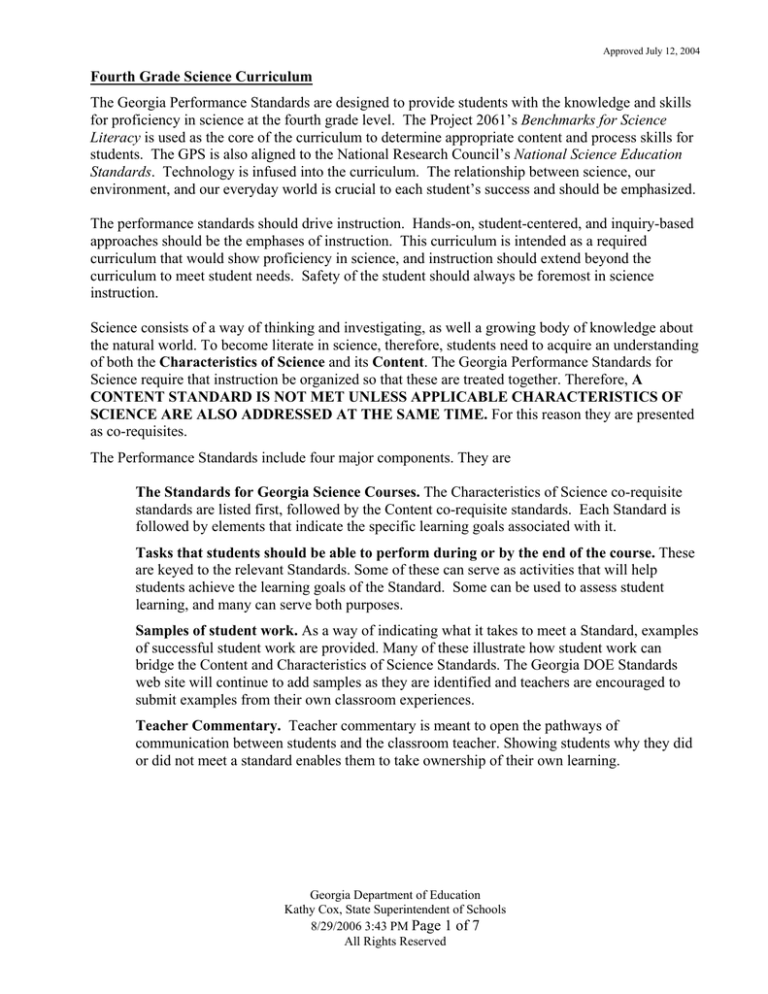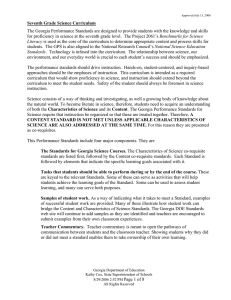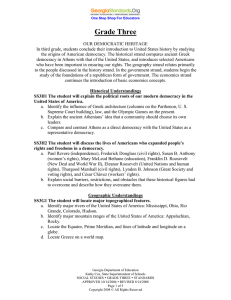
Approved July 12, 2004
Fourth Grade Science Curriculum
The Georgia Performance Standards are designed to provide students with the knowledge and skills
for proficiency in science at the fourth grade level. The Project 2061’s Benchmarks for Science
Literacy is used as the core of the curriculum to determine appropriate content and process skills for
students. The GPS is also aligned to the National Research Council’s National Science Education
Standards. Technology is infused into the curriculum. The relationship between science, our
environment, and our everyday world is crucial to each student’s success and should be emphasized.
The performance standards should drive instruction. Hands-on, student-centered, and inquiry-based
approaches should be the emphases of instruction. This curriculum is intended as a required
curriculum that would show proficiency in science, and instruction should extend beyond the
curriculum to meet student needs. Safety of the student should always be foremost in science
instruction.
Science consists of a way of thinking and investigating, as well a growing body of knowledge about
the natural world. To become literate in science, therefore, students need to acquire an understanding
of both the Characteristics of Science and its Content. The Georgia Performance Standards for
Science require that instruction be organized so that these are treated together. Therefore, A
CONTENT STANDARD IS NOT MET UNLESS APPLICABLE CHARACTERISTICS OF
SCIENCE ARE ALSO ADDRESSED AT THE SAME TIME. For this reason they are presented
as co-requisites.
The Performance Standards include four major components. They are
The Standards for Georgia Science Courses. The Characteristics of Science co-requisite
standards are listed first, followed by the Content co-requisite standards. Each Standard is
followed by elements that indicate the specific learning goals associated with it.
Tasks that students should be able to perform during or by the end of the course. These
are keyed to the relevant Standards. Some of these can serve as activities that will help
students achieve the learning goals of the Standard. Some can be used to assess student
learning, and many can serve both purposes.
Samples of student work. As a way of indicating what it takes to meet a Standard, examples
of successful student work are provided. Many of these illustrate how student work can
bridge the Content and Characteristics of Science Standards. The Georgia DOE Standards
web site will continue to add samples as they are identified and teachers are encouraged to
submit examples from their own classroom experiences.
Teacher Commentary. Teacher commentary is meant to open the pathways of
communication between students and the classroom teacher. Showing students why they did
or did not meet a standard enables them to take ownership of their own learning.
Georgia Department of Education
Kathy Cox, State Superintendent of Schools
8/29/2006 3:43 PM Page 1 of 7
All Rights Reserved
Approved July 12, 2004
Georgia Performance Science Standards-- Explanation of Coding
Characteristics of Science Standards
SKCS1
Science Kindergarten Characteristics of Science Standard #1
S8CS2
Science Grade 8 Characteristics of Science Standard #2
SCSh8
Science Characteristics of Science high school Standard #8
Content Standards
S5P3
Science Grade 5 Physical Science Standard #3
S4E2
Science Grade 4 Earth Science Standard #2
S7L4
Science Grade 7 Life Science Standard #4
SC1
Science Chemistry Standard #1
SB4
Science Biology Standard #4
SPS6
Science Physical Science Standard #6
SP3
Science Physics Standard #3
Georgia Department of Education
Kathy Cox, State Superintendent of Schools
8/29/2006 3:43 PM Page 2 of 7
All Rights Reserved
Approved July 12, 2004
Fourth grade students differentiate between observations and ideas. They speculate about
observations they make. They add, subtract, multiply and divide whole numbers on paper, mentally,
and with calculators. They list common materials for making simple mechanical constructions and
for repairing things. Fourth graders use records, tables, or graphs to identify patterns of change.
They write instructions and make sketches that allow others to carry out a scientific procedure. They
determine whether or not a comparison is fair if conditions are different for each thing being
compared. They question claims or statements made by people outside their field of expertise (such
as “4 out of 5 dentists say….”) Fourth graders know that safety is a fundamental concern in all
experimental science and adhere to rules and guidelines to show they are responsible with materials
and equipment.
Models
Fourth grade students gather and interpret data. They are able to construct meaningful models that
allow them to gain understanding of the natural world. Fourth grade students are active learners.
They do not simply read about science; they “do” science. As a result, fourth grade students are able
to differentiate observations from ideas. Students engage in investigations inside and outside the
classroom.
Major Concepts/Skills:
Concepts/Skills to Maintain:
Earth Science
Habits of Mind
Stars and star patterns
Asks questions that lead to investigations
Solar System
Conducts simple investigations
Weather—data and forecasting
Uses tools for collecting data
Physical Science
Uses charts and graphs
Light
Uses data to answer questions
Sound
Writes and uses instructions
Force, mass, and motion (simple machines) Understands fairness
Effects of gravity
Justifies reasonable answers
Life Science
Identifies patterns of change
Ecosystems
Researches for information
Food web/Food chain
Understands the importance of safety concerns
Adaptation-survival/extinction
Co-Requisite - Characteristics of Science
Habits of the Mind
S4CS1. Students will be aware of the importance of curiosity, honesty, openness, and
skepticism in science and will exhibit these traits in their own efforts to understand
how the world works.
a. Keep records of investigations and observations and do not alter the records later.
b. Carefully distinguish observations from ideas and speculation about those
observations.
c. Offer reasons for findings and consider reasons suggested by others.
d. Take responsibility for understanding the importance of being safety conscious.
Georgia Department of Education
Kathy Cox, State Superintendent of Schools
8/29/2006 3:43 PM Page 3 of 7
All Rights Reserved
Approved July 12, 2004
S4CS2. Students will have the computation and estimation skills necessary for analyzing data
and following scientific explanations.
a. Add, subtract, multiply, and divide whole numbers mentally, on paper, and with a
calculator.
b. Use fractions and decimals, and translate between decimals and commonly
encountered fractions – halves, thirds, fourths, fifths, tenths, and hundredths (but not
sixths, sevenths, and so on) – in scientific calculations.
c. Judge whether measurements and computations of quantities, such as length, area,
volume, weight, or time, are reasonable answers to scientific problems by comparing
them to typical values.
S4CS3. Students will use tools and instruments for observing, measuring, and manipulating
objects in scientific activities utilizing safe laboratory procedures.
a. Choose appropriate common materials for making simple mechanical constructions
and repairing things.
b. Measure and mix dry and liquid materials in prescribed amounts, exercising
reasonable safety.
c. Use computers, cameras and recording devices for capturing information.
d. Identify and practice accepted safety procedures in manipulating science materials
and equipment.
S4CS4. Students will use ideas of system, model, change, and scale in exploring scientific and
technological matters.
a. Observe and describe how parts influence one another in things with many parts.
b. Use geometric figures, number sequences, graphs, diagrams, sketches, number lines,
maps, and stories to represent corresponding features of objects, events, and
processes in the real world. Identify ways in which the representations do not match
their original counterparts.
c. Identify patterns of change in things—such as steady, repetitive, or irregular
change—using records, tables, or graphs of measurements where appropriate.
S4CS5. Students will communicate scientific ideas and activities clearly.
a. Write instructions that others can follow in carrying out a scientific procedure.
b. Make sketches to aid in explaining scientific procedures or ideas.
c. Use numerical data in describing and comparing objects and events.
d. Locate scientific information in reference books, back issues of newspapers and
magazines, CD-ROMs, and computer databases.
S4CS6. Students will question scientific claims and arguments effectively.
a. Support statements with facts found in books, articles, and databases, and identify the
sources used.
b. Identify when comparisons might not be fair because some conditions are different.
Georgia Department of Education
Kathy Cox, State Superintendent of Schools
8/29/2006 3:43 PM Page 4 of 7
All Rights Reserved
Approved July 12, 2004
The Nature of Science
S4CS7. Students will be familiar with the character of scientific knowledge and how it is
achieved.
Students will recognize that:
a. Similar scientific investigations seldom produce exactly the same results, which may
differ due to unexpected differences in whatever is being investigated, unrecognized
differences in the methods or circumstances of the investigation, or observational
uncertainties.
b. Some scientific knowledge is very old and yet is still applicable today.
S4CS8. Students will understand important features of the process of scientific inquiry.
Students will apply the following to inquiry learning practices:
a. Scientific investigations may take many different forms, including observing what
things are like or what is happening somewhere, collecting specimens for analysis,
and doing experiments.
b. Clear and active communication is an essential part of doing science. It enables
scientists to inform others about their work, expose their ideas to criticism by other
scientists, and stay informed about scientific discoveries around the world.
c. Scientists use technology to increase their power to observe things and to measure
and compare things accurately.
d. Science involves many different kinds of work and engages men and women of all
ages and backgrounds.
Co-Requisite - Content
Earth Science
S4E1. Students will compare and contrast the physical attributes of stars, star patterns, and
planets.
a. Recognize the physical attributes of stars in the night sky such as number, size, color
and patterns.
b. Compare the similarities and differences of planets to the stars in appearance,
position, and number in the night sky.
c. Explain why the pattern of stars in a constellation stays the same, but a planet can be
seen in different locations at different times.
d. Identify how technology is used to observe distant objects in the sky.
S4E2. Students will model the position and motion of the earth in the solar system and will
explain the role of relative position and motion in determining sequence of the phases
of the moon.
a. Explain the day/night cycle of the earth using a model.
b. Explain the sequence of the phases of the moon.
c. Demonstrate the revolution of the earth around the sun and the earth’s tilt to explain
the seasonal changes.
d. Demonstrate the relative size and order from the sun of the planets in the solar
system.
Georgia Department of Education
Kathy Cox, State Superintendent of Schools
8/29/2006 3:43 PM Page 5 of 7
All Rights Reserved
Approved July 12, 2004
S4E3. Students will differentiate between the states of water and how they relate to the water
cycle and weather.
a. Demonstrate how water changes states from solid (ice) to liquid (water) to gas (water
vapor/steam) and changes from gas to liquid to solid.
b. Identify the temperatures at which water becomes a solid and at which water becomes
a gas.
c. Investigate how clouds are formed.
d. Explain the water cycle (evaporation, condensation, and precipitation).
e. Investigate different forms of precipitation and sky conditions. (rain, snow, sleet, hail,
clouds, and fog).
S4E4. Students will analyze weather charts/maps and collect weather data to predict weather
events and infer patterns and seasonal changes.
a. Identify weather instruments and explain how each is used in gathering weather data
and making forecasts (thermometer, rain gauge, barometer, wind vane, anemometer).
b. Using a weather map, identify the fronts, temperature, and precipitation and use the
information to interpret the weather conditions.
c. Use observations and records of weather conditions to predict weather patterns
throughout the year.
d. Differentiate between weather and climate.
Physical Science
S4P1. Students will investigate the nature of light using tools such as mirrors, lenses, and
prisms.
a. Identify materials that are transparent, opaque, and translucent.
b. Investigate the reflection of light using a mirror and a light source.
c. Identify the physical attributes of a convex lens, a concave lens, and a prism and
where each is used.
S4P2. Students will demonstrate how sound is produced by vibrating objects and how sound
can be varied by changing the rate of vibration.
a. Investigate how sound is produced.
b. Recognize the conditions that cause pitch to vary.
S4P3. Students will demonstrate the relationship between the application of a force and the
resulting change in position and motion on an object.
a. Identify simple machines and explain their uses (lever, pulley, wedge, inclined plane,
screw, wheel and axle).
b. Using different size objects, observe how force affects speed and motion.
c. Explain what happens to the speed or direction of an object when a greater force than
the initial one is applied.
d. Demonstrate the effect of gravitational force on the motion of an object.
Teacher note: The use of mathematical formulas is not recommended in S4P3. Fourth grade
students should carry out investigations to provide a foundation of concrete experience for the
abstract understandings of physical science in upper grades.
Georgia Department of Education
Kathy Cox, State Superintendent of Schools
8/29/2006 3:43 PM Page 6 of 7
All Rights Reserved
Approved July 12, 2004
Life Science
S4L1. Students will describe the roles of organisms and the flow of energy within an ecosystem.
a. Identify the roles of producers, consumers, and decomposers in a community.
b. Demonstrate the flow of energy through a food web/food chain beginning with
sunlight and including producers, consumers, and decomposers.
c. Predict how changes in the environment would affect a community (ecosystem) of
organisms.
d. Predict effects on a population if some of the plants or animals in the community are
scarce or if there are too many.
S4L2. Students will identify factors that affect the survival or extinction of organisms such as
adaptation, variation of behaviors (hibernation), and external features (camouflage and
protection).
a. Identify external features of organisms that allow them to survive or reproduce better
than organisms that do not have these features (for example: camouflage, use of
hibernation, protection, etc.).
b. Identify factors that may have led to the extinction of some organisms.
Georgia Department of Education
Kathy Cox, State Superintendent of Schools
8/29/2006 3:43 PM Page 7 of 7
All Rights Reserved












